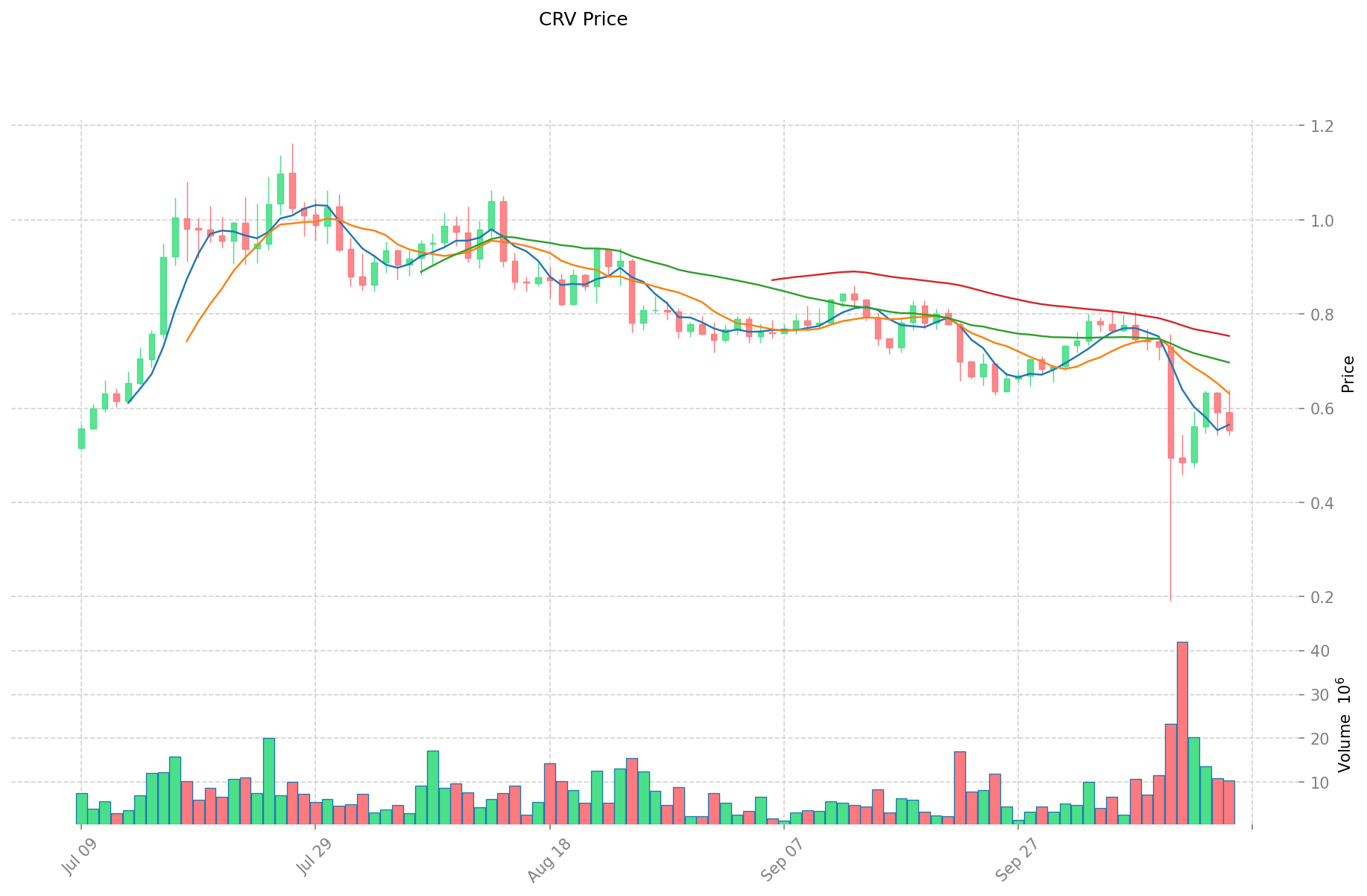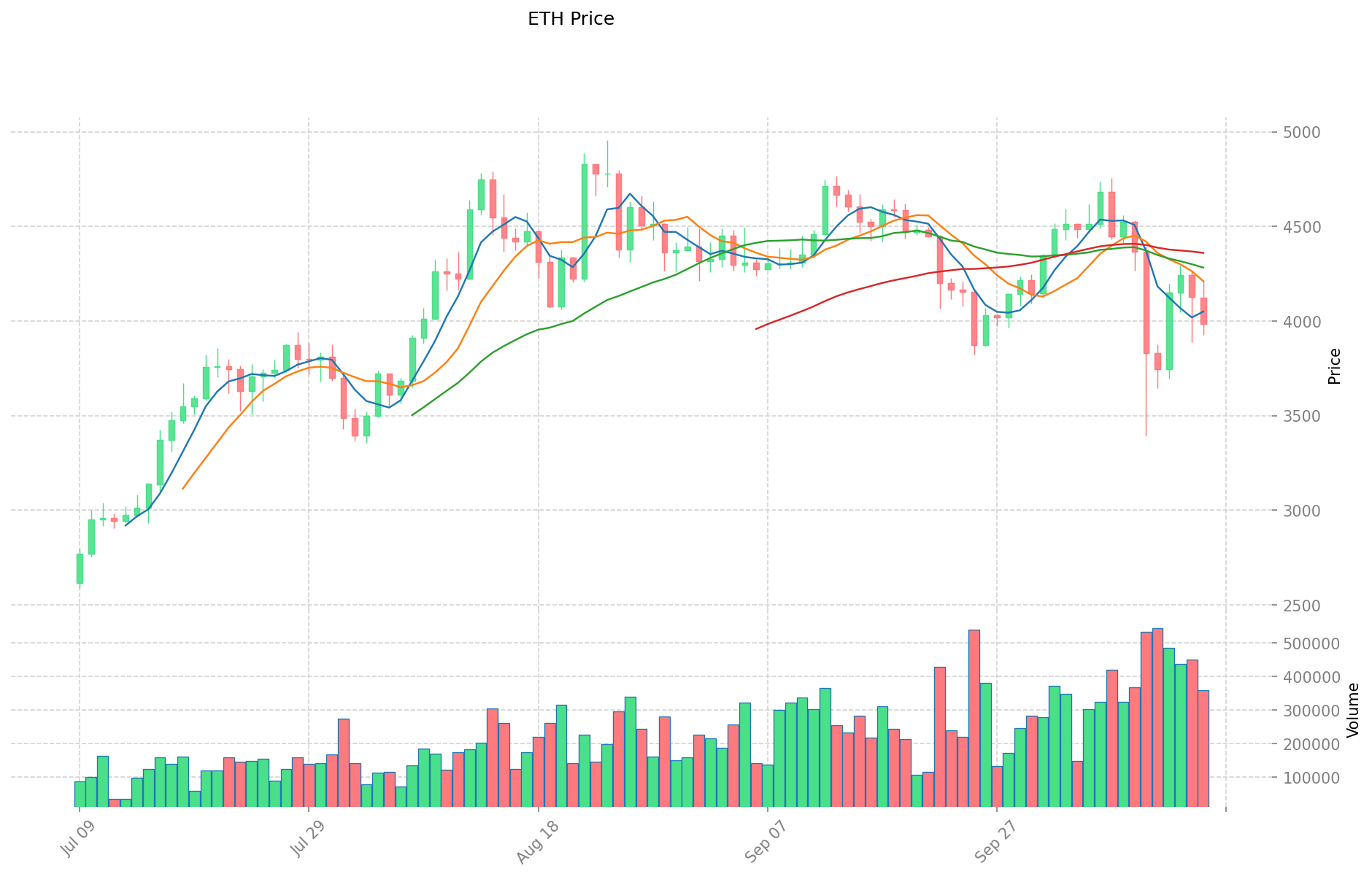CRV ve ETH: DeFi'de Getiri Sağlama Olanaklarının Karşılaştırmalı Analizi

Giriş: CRV ve ETH Yatırımı Karşılaştırması
Kripto para piyasasında Curve (CRV) ve Ethereum (ETH) kıyaslaması, yatırımcıların göz ardı edemeyeceği bir konudur. Bu iki kripto varlık; piyasa değeri, kullanım alanları ve fiyat performansı bakımından ciddi farklılıklar gösterirken, kripto varlık ekosisteminde de ayrı pozisyonlara sahiptir.
Curve (CRV): Ocak 2020’de piyasaya sürülmesinden itibaren, merkeziyetsiz finans (DeFi) alanında yüksek verimli stablecoin ticaretiyle piyasa tarafından benimsenmiştir.
Ethereum (ETH): 2015’te hayata geçirilmesinden bu yana merkeziyetsiz uygulamalar ve akıllı sözleşmelerin temeli olarak kabul edilmekte olup, küresel işlem hacmi ve piyasa değeri açısından en büyük kripto paralardan biridir.
Bu makale, CRV ve ETH’nin yatırım değerini tarihsel fiyat eğilimleri, arz mekanizmaları, kurumsal benimseme, teknolojik ekosistemler ve gelecek tahminleri ekseninde kapsamlı biçimde analiz ederek yatırımcıların en çok merak ettiği soruyu yanıtlamayı amaçlamaktadır:
"Şu anda hangisi daha avantajlı bir alım fırsatı?"
I. Fiyat Geçmişi Karşılaştırması ve Güncel Piyasa Görünümü
CRV ve ETH Fiyat Geçmişi
- 2020: CRV, Ocak ayında piyasaya sürüldü ve yeni bir DeFi tokenı olarak fiyat dalgalanmaları yaşadı.
- 2022: ETH, The Merge ile Proof of Stake’e geçti ve bu dönüşüm fiyatında belirleyici oldu.
- Karşılaştırmalı analiz: Son piyasa döngüsünde CRV, tüm zamanların en yüksek seviyesi olan $15,37’den $0,180354’e kadar gerilerken; ETH, $4.946,05’ten mevcut fiyatına düşerek daha istikrarlı bir seyir izledi.
Güncel Piyasa Durumu (16 Ekim 2025)
- CRV güncel fiyatı: $0,551
- ETH güncel fiyatı: $3.981,2
- 24 saatlik işlem hacmi: CRV $6.075.394,99, ETH $1.426.280.738,19
- Piyasa Duyarlılık Endeksi (Korku & Açgözlülük): 28 (Korku)
Anlık fiyatları görmek için tıklayın:
- CRV güncel fiyatı için Piyasa Fiyatı
- ETH güncel fiyatı için Piyasa Fiyatı


Yatırım Değerini Belirleyen Unsurlar: CRV ve ETH
Arz Mekanizmaları (Tokenomik)
- CRV: veCRV kilitleme modeli, ücret dağıtımı (crvUSD ile fiyatlanır) ve stablecoin likiditesini koruyan; yönetişim ve teşvik tokenı
- ETH: Gaz ücretlerinin yakılmasıyla deflasyonist mekanizma; staking ile yıllık %3-4 getiri
- 📌 Tarihsel desen: CRV’nin değeri stablecoin piyasasındaki güçlü konumuna dayanırken, ETH’nin deflasyonist yapısı ekosistem arttıkça güçleniyor
Kurumsal Benimseme ve Piyasa Kullanımı
- Kurumsal portföyler: ETH, ETF ürünleriyle ciddi kurumsal ilgi görürken CRV ağırlıklı olarak DeFi içinde kullanılıyor
- Ticari uygulamalar: ETH, blokzincir projelerinin temel altyapısıyken; CRV stablecoin değişimi ve “DeFi makbuzları” piyasasında uzmanlaşıyor
- Düzenleyici ortam: ETH ETF’leri düzenleyici onay alırken, CRV gibi özel DeFi tokenları daha sınırlı kabul görüyor
Teknolojik Gelişim ve Ekosistem
- CRV teknik yenilikleri: Curve V2, sabit olmayan varlıklar için dinamik sabitleme sunuyor; EMA oracle ile sabit çarpan formüllerine göre 5-10 kat daha yüksek likidite sağlanıyor
- ETH teknik yol haritası: RISC-V mimarisi (2025-2030) ile 3-5 kat işlem hızı ve %50’den fazla gaz ücreti indirimi; ZK-proof’larla 10 saniyede blok doğrulama
- Ekosistem karşılaştırması: ETH tüm DeFi ekosisteminin altyapısı; CRV stablecoin piyasasında uzmanlaşmış ve döviz ticaretine açılmıştır
Makroekonomik Etkenler ve Piyasa Döngüleri
- Enflasyon performansı: ETH, kurumsal destek ve ETF ile daha güçlü değer saklama özelliği gösterir
- Para politikası etkisi: ETH piyasası, geleneksel finans ve faiz hareketlerini yakından takip eder
- Sınır ötesi dinamikler: ETH, kurumsal pozisyonlanmayla küresel mutabakat katmanı; CRV ise DeFi ekosistemiyle sınırlı kalır
III. 2025-2030 Fiyat Tahmini: CRV ve ETH
Kısa Vadeli Tahmin (2025)
- CRV: Muhafazakar $0,41-$0,55 | İyimser $0,55-$0,60
- ETH: Muhafazakar $2.667-$3.981 | İyimser $3.981-$4.140
Orta Vadeli Tahmin (2027)
- CRV, büyüme dönemine girebilir; tahmini fiyatı $0,54-$0,79
- ETH, konsolidasyon dönemine girebilir; tahmini fiyatı $4.288-$4.913
- Başlıca etkenler: Kurumsal girişler, ETF’ler, ekosistem gelişimi
Uzun Vadeli Tahmin (2030)
- CRV: Temel senaryo $0,93-$1,06 | İyimser senaryo $1,06-$1,46
- ETH: Temel senaryo $3.608-$6.221 | İyimser senaryo $6.221-$9.269
Feragatname
CRV:
| Yıl | Tahmini En Yüksek Fiyat | Tahmini Ortalama Fiyat | Tahmini En Düşük Fiyat | Artış/Azalış Oranı |
|---|---|---|---|---|
| 2025 | 0,598752 | 0,5544 | 0,410256 | 0 |
| 2026 | 0,85333248 | 0,576576 | 0,4612608 | 4 |
| 2027 | 0,7935992064 | 0,71495424 | 0,5433652224 | 29 |
| 2028 | 1,123872317568 | 0,7542767232 | 0,41485219776 | 36 |
| 2029 | 1,17384315048 | 0,939074520384 | 0,59161694784192 | 70 |
| 2030 | 1,45791319289616 | 1,056458835432 | 0,92968377518016 | 91 |
ETH:
| Yıl | Tahmini En Yüksek Fiyat | Tahmini Ortalama Fiyat | Tahmini En Düşük Fiyat | Artış/Azalış Oranı |
|---|---|---|---|---|
| 2025 | 4.140,032 | 3.980,8 | 2.667,136 | 0 |
| 2026 | 4.872,4992 | 4.060,416 | 2.801,68704 | 1 |
| 2027 | 4.913,10336 | 4.466,4576 | 4.287,799296 | 12 |
| 2028 | 5.721,5321856 | 4.689,78048 | 2.673,1748736 | 17 |
| 2029 | 7.235,862302592 | 5.205,6563328 | 2.654,884729728 | 30 |
| 2030 | 9.268,93138336704 | 6.220,759317696 | 3.608,04040426368 | 56 |
IV. Yatırım Stratejisi Karşılaştırması: CRV ve ETH
Uzun Vadeli ve Kısa Vadeli Yatırım Stratejileri
- CRV: DeFi getirisi ve stablecoin piyasası büyümesine odaklanan yatırımcılar için uygundur
- ETH: Kurumsal benimseme ve uzun vadeli değer potansiyeliyle daha yerleşik bir ekosistem arayan yatırımcılar için uygundur
Risk Yönetimi ve Varlık Dağılımı
- Temkinli yatırımcılar: CRV %10, ETH %90
- Agresif yatırımcılar: CRV %30, ETH %70
- Riskten korunma araçları: Stablecoin tahsisi, opsiyonlar, çapraz döviz portföyleri
V. Potansiyel Risk Karşılaştırması
Piyasa Riski
- CRV: Daha düşük piyasa değeri ve DeFi’ye özgü faktörlerden kaynaklı yüksek dalgalanma
- ETH: Daha geniş kripto piyasa trendleri ve makroekonomik faktörlere duyarlı
Teknik Risk
- CRV: Ölçeklenebilirlik, ağ istikrarı, akıllı sözleşme açıkları
- ETH: Uygulama istemcisi merkezileşmesi, Layer 2 çözümlerinde olası güvenlik açıkları
Düzenleyici Risk
- Küresel düzenleme politikaları, ETH’nin büyük piyasa varlığı nedeniyle daha etkileyici olabilir; CRV ise DeFi’ye özgü düzenlemelerle karşı karşıya kalabilir
VI. Sonuç: Hangisi Daha Avantajlı Bir Alım?
📌 Yatırım Değeri Özeti:
- CRV avantajları: Stablecoin piyasasında uzmanlık, DeFi ekosisteminde yüksek getiri potansiyeli, veCRV ile yenilikçi tokenomik
- ETH avantajları: Yerleşik ekosistem, kurumsal benimseme, deflasyonist mekanizma, DeFi’nin ötesinde geniş kullanım
✅ Yatırım Tavsiyesi:
- Yeni yatırımcılar: ETH’ye daha yüksek pay ayırıp istikrarlı piyasa ve düşük volatiliteyi tercih edebilir
- Deneyimli yatırımcılar: Her iki kripto varlığı içeren dengeli portföy, risk toleransı ve DeFi beklentisine göre şekillenmeli
- Kurumsal yatırımcılar: ETH’ye odaklanıp düzenleyici netlik ve altyapı avantajı sağlarken, DeFi’ye maruz kalmak için CRV’ye küçük bir pay ayırabilir
⚠️ Risk Uyarısı: Kripto para piyasası yüksek dalgalanma taşır ve bu metin yatırım tavsiyesi değildir. None
VII. SSS
S1: Yatırım potansiyeli açısından CRV ve ETH arasındaki temel farklar nelerdir? C: CRV stablecoin piyasası ve DeFi getirisiyle yüksek potansiyel sunarken volatilitesi yüksektir. ETH ise daha yerleşik ekosistem, kurumsal benimseme ve geniş uygulama temeliyle daha sağlam ve uzun vadeli büyüme fırsatı sağlar.
S2: CRV ve ETH’nin arz mekanizmaları nasıl karşılaştırılır? C: CRV, veCRV kilitleme ve ücret dağıtımıyla değer yakalayan yönetişim ve teşvik token modeline sahiptir. ETH, gaz ücreti yakımıyla deflasyonist mekanizma ve %3-4 yıllık staking getirisi sunar.
S3: Kurumsal yatırımcılar için hangi varlık daha uygundur? C: ETH, düzenleyici netlik, altyapı ve ETF ürünleriyle kurumsal yatırımcılar için daha uygundur. CRV ise DeFi’ye maruz kalmak isteyenler için düşük payla değerlendirilebilir.
S4: 2030 yılında CRV ve ETH için öngörülen fiyat aralıkları nedir? C: Tahminlere göre, 2030’da CRV $0,93-$1,46; ETH ise $3.608-$9.269 aralığında olabilir.
S5: CRV ve ETH yatırımlarında risk yönetimi nasıl olmalı? C: Temkinli yatırımcılar CRV’ye %10, ETH’ye %90 pay ayırabilirken, agresif yatırımcılar %30 CRV, %70 ETH tercih edebilir. Stablecoin, opsiyon ve çapraz döviz portföyleriyle riskten korunulabilir.
S6: CRV ve ETH için başlıca teknik riskler nelerdir? C: CRV, ölçeklenebilirlik, ağ istikrarı ve akıllı sözleşme açıklarına; ETH ise istemci merkezileşmesi ve Layer 2 güvenlik sorunlarına karşı risk taşır.
S7: Makroekonomik faktörler CRV ve ETH’yi nasıl farklı şekilde etkiler? C: ETH, finansal piyasa duyarlılığı ve faiz ortamına daha yakından bağlı olup küresel mutabakat katmanıdır. CRV ise DeFi ekosisteminde uzmanlaşmıştır ve genel makroekonomik trendlerden daha az etkilenir.

Tribe (TRIBE) iyi bir yatırım mı?: Bu merkeziyetsiz sosyal medya tokeninin potansiyelini ve risklerini değerlendiriyoruz

Ethena (ENA) yatırım için uygun mu?: Bu yeni stablecoin protokolünün potansiyeli üzerine analiz

Tribe (TRIBE) iyi bir yatırım mı?: 2024 yılında Riskler, Potansiyel Getiriler ve Piyasa Konumunun Kapsamlı Analizi

bir kripto coin bir ETF aldığında..

Şu Anda Alınacak En İyi Kripto: Akıllı Yatırımcılar için 2025 Rehberi

2025 UNI Fiyat Tahmini: Boğa Sonrası Piyasa Döneminde Uniswap'ın Token Değerlemesini Belirleyecek Temel Faktörlerin Analizi

Meme Finansını Keşfetmek: Yenilikçi Web3 Platformlarına Kapsamlı Bir Rehber

Bitcoin Layer 2 Akıllı Sözleşmeler ve DeFi’ye Yaklaşım: Temel Bir Kılavuz

Web3 cüzdanlarında unutulan PIN kodlarının kurtarılması: PIN yenileme sürecini etkin şekilde yönetmek

Fuel ağı ve FUEL tokenı: Tanıtım ve nasıl çalışır?

ZKFair Launchpool: FairStake Fırsatları İçin Kapsamlı Kılavuz







